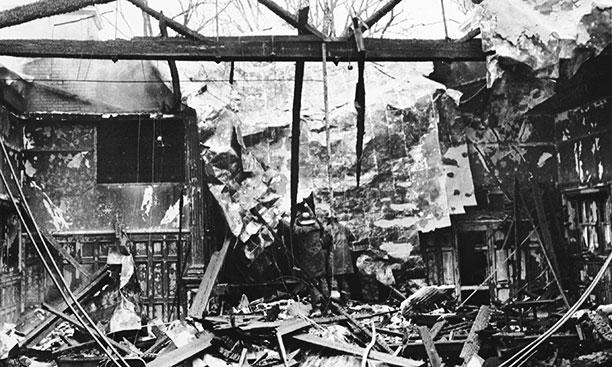
Fire has taken a toll on Princeton’s campus, most notably in 1802 and 1855, when Nassau Hall was gutted. The first half of the 20th century was inauspicious, with flames consuming Marquand Chapel and Dickinson Hall in 1920, the John C. Green School of Science in 1928, and the University Gymnasium in 1944, but only one major conflagration has occurred since then: the destruction of Whig Hall on Nov. 9, 1969.
The neoclassical edifice and its sister, Clio Hall, had graced the University’s architectural landscape since 1893, replacing similar structures erected in 1838. But around 5:30 a.m., proctors discovered a blaze that would reduce the home of the American Whig-Cliosophic Society to a roofless shell.
Although the fire was blamed on “human carelessness” — likely a cigarette — the editors of The Daily Princetonian also reproached the University for not doing more to safeguard the building, noting, “The smoke sensors now being installed in dormitories did not exist in Whig Hall. ... Only fire extinguishers — helpful only in the smallest blazes — were provided.”
Officers made a valiant attempt to combat the fire in this way, but it took the efforts of three fire departments to quench the flames, which at their most intense shot 20 feet into the air. Mercifully, no one was injured, and according to the Prince, firefighters managed to remove “about 25 paintings, six typewriters, an Addressograph machine, and 26 captain’s chairs.” But “several choice paintings, a movie projector, a color television set, and the Society’s new $400 pool table” were lost.
The reconstruction of Whig Hall took three years and proved contentious, both in terms of its insurance valuation and architectural design. Recognizing that the cost of replicating its richly ornamented interior would be prohibitive, Whig-Clio President Christopher G. Lee ’70 predicted the building would feature “a charming mixture of concrete and plastic,” but even the prescient could not have guessed its future sobriquet, the “Yellow Submarine” — a nod to the color of many of its doors and their porthole-like openings.
John S. Weeren is founding director of Princeton Writes and a former assistant University archivist.
